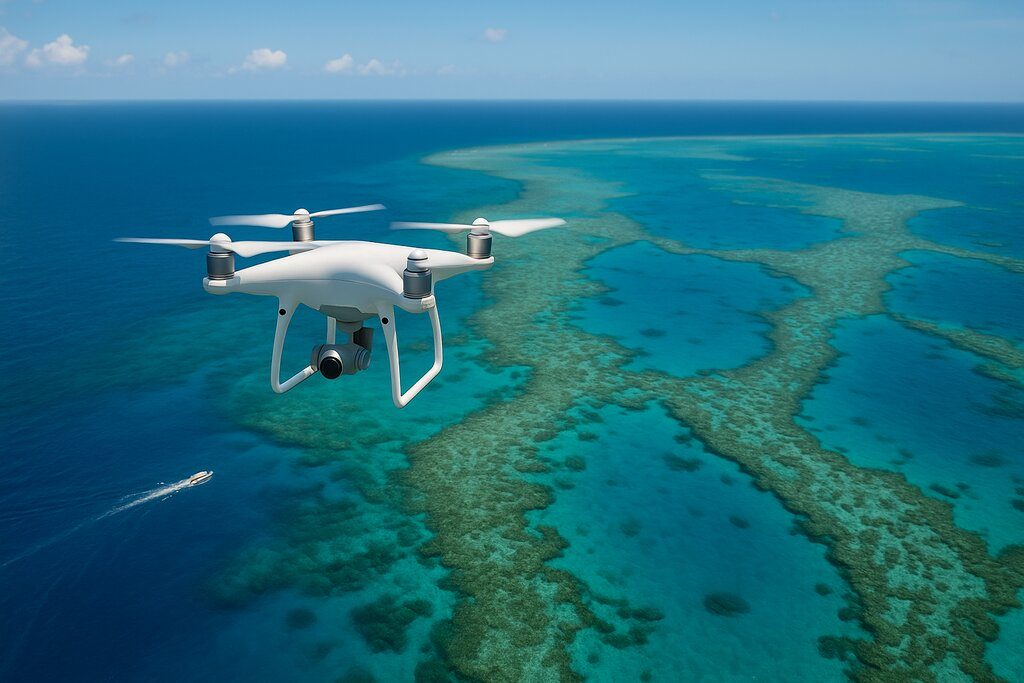Drone Rules for the Great Barrier Reef: What You Need to Know
The Great Barrier Reef is one of the most iconic and protected natural wonders on the planet. Spanning over 2,300 kilometres along Queensland’s coastline, it’s a haven for marine life, tourism, and stunning aerial photography. But can you fly a drone over the Great Barrier Reef? The short answer is: yes, in some places, under certain conditions. However, there are strict rules, local restrictions, and ethical responsibilities involved. In this post, we’ll explore the regulations and tips for safe drone flying over the reef, including locations like Hamilton Island and the Whitsunday Islands.

The Ultimate Guide to Fly Your Drone Over the Great Barrier Reef
Australia’s Civil Aviation Safety Authority (CASA) governs drone (or remotely piloted aircraft, RPA) operations across the country. Their regulations apply no matter where you fly, but additional local rules often exist when flying in national parks, marine reserves, or tourism hotspots like the Great Barrier Reef. Before launching your drone, you need to understand both CASA laws and the specific site-based restrictions in the area you’re visiting.
General CASA Rules for Flying a Drone in Australia
- You must keep your drone within visual line of sight (VLOS) at all times.
- Only fly during daylight hours and in good weather conditions.
- Do not fly higher than 120 metres (400 feet) above ground level.
- Stay at least 30 metres away from other people.
- Do not fly over or near emergency situations (e.g., accidents or fires).
- If you’re flying for commercial purposes, you need a Remote Pilot Licence (RePL) and potentially an Operator’s Certificate (OC).
Can I Fly My Drone at the Great Barrier Reef?
The reef is managed by the Great Barrier Reef Marine Park Authority (GBRMPA). While CASA governs how you fly, GBRMPA determines where and whether you can fly. In general, recreational drone flying is not permitted over designated protected zones without prior permission. These areas include many of the reef’s most famous sections and marine tourism zones.
However, some parts of the reef that aren’t under restricted zones may allow drone use, particularly from private boats or low-use beaches. Always check the GBRMPA zoning map and seek written permission if you’re unsure. Failing to comply with marine park laws can result in serious fines.
Flying Drones/Remotely Piloted Aircraft at Hamilton Island
Hamilton Island is a privately operated resort island and has strict no-drone policies for recreational visitors. Even licensed commercial drone pilots need special permission to operate on the island. This is mainly to ensure guest privacy and safety. If you’re planning to capture aerial footage on or near Hamilton Island, contact the Hamilton Island Enterprises Group well in advance to apply for permission.
Can I Fly a Drone in the Whitsunday Islands?
The Whitsundays fall under both GBRMPA and Queensland Parks and Wildlife Service (QPWS) jurisdiction. Many islands are within protected national parks, meaning drones are generally prohibited without a permit. Whitehaven Beach, Hill Inlet, and other popular Whitsunday locations are drone-restricted zones due to high visitor numbers and environmental sensitivity.
That said, certain lesser-known locations and nearby areas may be drone-friendly. If you’re operating commercially or want to fly legally in a restricted zone, you must apply for a commercial filming permit from QPWS and potentially a GBRMPA permit as well.
Tips for Drone Use Around the Great Barrier Reef
- Always check local laws and obtain relevant permits before flying.
- Use apps like OpenSky or AirMap to confirm airspace permissions.
- Avoid flying over sensitive marine life, nesting birds, or busy tourism spots.
- Use polarising filters to reduce glare over water and enhance your reef imagery.
- Consider launching from a private vessel in permitted areas for the best angles.
- If you’re unsure about permissions or how to fly safely, contact us and we’ll help organise the shoot professionally.
Why Work with a Licensed Drone Operator?
Even if you’re an experienced drone enthusiast, operating in areas like the Great Barrier Reef involves complexities you may not be familiar with. That’s where Flying Glass comes in. As a licensed drone operator holding an Operator’s Certificate (OC), we’re authorised to fly in restricted areas with the correct approvals. We manage all regulatory permissions and ensure that every shoot is legally compliant and environmentally responsible.
If you’re a filmmaker, tourism provider, or brand wanting breathtaking reef visuals, we can handle the entire shoot—from preflight approvals to post-production. Or if you’re keen to get your own Remote Pilot Licence (RePL) and learn the rules to fly commercially across Australia, including the Great Barrier Reef region, our drone training courses are the ideal starting point.
Can I Fly a Drone Over Great Barrier Reef Without Permission?
No, not in most cases. While open airspace may exist over certain parts of the reef, the underlying marine zoning restrictions usually prohibit drone flights without permission. Whether launching from a boat or beach, your drone is considered to be operating in the Marine Park. That means you’re subject to GBRMPA rules even if you’re above the water, not in it.
Drone flights without the required permits can attract fines or even prosecution. Permission requirements vary depending on whether you’re a hobbyist or operating commercially, so always check before flying.
Final Thoughts
So, can you fly a drone over the Great Barrier Reef? Yes—with planning, permits, and respect for the environment. Whether you’re exploring Hamilton Island, the Whitsundays, or lesser-known reef areas, your drone footage can showcase the reef’s majesty, but only if flown responsibly.
Need help with permissions or want professional-grade reef footage? Reach out to Flying Glass. We know the rules, we’ve got the gear, and we’re ready to fly.

